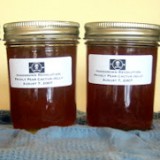Here's how to make one, according to this NatGeo article:
For clarity's sake, they're suggesting you mix everything in a container
(Note: the original experiment actually used a carved out soda bottle for this, which would make more sense than a coffee cup) and then put that container in the center of the upturned/overturned/upside down dog bowl. The CO2 reaction in the large container will attract the bugs, and when they get into the upside down dog bowl, the sloped sides will trap the bed bugs like a moat so they can't get out. According to the study (linked below) they also sprayed some adhesive on the sides of the bowl just to boost the efficacy of the trap.
In any event, the yeast eats the sugar, and releases carbon dioxide, like humans do when they exhale. It's also the gas that bed bugs use to find sleeping hosts, and they're very good at tracking carbon dioxide, even across long distances.
The trap won't kill the bed bugs, but it will catch them, and Rutgers University entomologists Narinderpal Singh, Changlu Wang, and Richard Cooper all agree that it can detect signs of an infestation early enough to be quickly and swiftly dealt with. The researchers even put their test up against the leading commercial version and found that their method was much more effective at keeping trapped bed bugs inside, so your positive result doesn't escape, leaving you to think everything's fine. You can read the whole study (or at least the abstract), in the Journal of Economic Entomology (click the PDF button to get the full version of the study), or hit the National Geographic link below for more details on how the test was developed
Bed-bugs-nestling-in-unexpected-places even in new funiture, has the van that hauled the chair been cleaned?
http://www.americanownews.com/story/15514309/study-says-bed-bugs-can-carry-bacteria
UPDATE: New information from a study shows some bed bugs can carry drug resistant bacteria - even MRSA.
Five bed bugs were tested and experts say while they carry the superbug bacteria, they are unclear of how bed bugs got the bacteria.
Dr. Scott Mahan, an infectious disease specialist, says there hasn't been any association between the bed bugs transmitting the disease to humans.
Mahan also says while the bacteria is drug resistant, "They are resistant to the drugs we used maybe 10 or 15 years ago. That doesn't mean there aren't drugs that can work against them."
So the bottom line - try and avoid bed bugs if you can.
TRY: the dryer sheets under mattress to keep them away, and in suit cases as you travel.
http://www.cdc.gov/parasites/bedbugs/faqs.html




